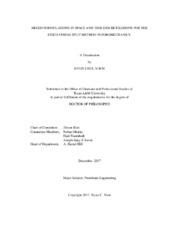| dc.description.abstract | Coupled flow and geomechanics become one of the important research topics in oil and
gas industry for development of unconventional petroleum reservoirs such as gas shale,
tight gas, and gas hydrates. In particular, these reservoirs are naturally born with its complex
behavior, exhibiting strong non-linearity, anisotropy, and heterogeneity effects within
each geomaterial and fluid by itself. In addition, the coupling between flow and geomechanics
is more complicated for unconsolidated reservoirs or shale formations. Thus, it is
critical to assess these complex coupled processes properly through poromechanics with
forward numerical simulation and to provide more accurate solutions in order to predict
the reservoir performance more precisely.
The main objective of this study is to address several numerical issues that are accompanied
with simulation in poromechanics. We perform in-depth analysis on mathematical
conditions to satisfy for numerically stable and accurate solution, employing various
mixed formulations in space and time discretization.
Specifically, in space discretization, we deal with the spatial instability that occurs at
early times in poromechanics simulation, such as a consolidation problem. We identify
two types of spatial instabilities caused by violation of two different conditions: the condition
due to discontinuity in pressure and the inf-sup condition related to incompressible
fluid, which both occur at early times. We find that the fixed-stress split with the finite
volume method for flow and finite element method for geomechanics can provide stability
in space, allowing discontinuity of pressure and circumventing violation of the inf-sup
condition.
In time discretization, we investigate the order of accuracy in time integration with the
fixed-stress sequential method. In the study, two-pass and deferred correction methods are to be considered for studying the high-order methods in time integration. We find
that there are two different inherent constraint structures that still cause order reductions
against high-order accuracy while applying the two methods.
As an additional in-depth analysis, we study a large deformation system, considering
anisotropic properties for geomechanical and fluid flow parameters, the traverse isotropy
and permeability anisotropy ratio. Seeking more accurate solutions, we adopt the total
Lagrangian method in geomechanics and multi-point flux approximation in fluid flow. By
comparing it to the infinitesimal transformation with two-point flux approximation, we
find that substantial differences between the two approaches can exist.
For a field application, we study large-scale geomechanics simulation that can honor
measured well data, which leads to a constrained geomechanics problem. We employ the
Uzawa’s algorithm to solve the saddle point problem from the constrained poromechanics.
From numerical parallel simulations, we estimate initial stress distribution in the shale gas
reservoir, which will be used for the field development plan.
From this study, we find several mathematical conditions for numerically stable and accurate
solution of poromechanics problems, when we take the various mixed formulations.
By considering the conditions, we can overcome the numerical issues. Then, reliable and
precise prediction of reservoir behavior can be obtained for coupled flow-geomechanics
problems. | en |


